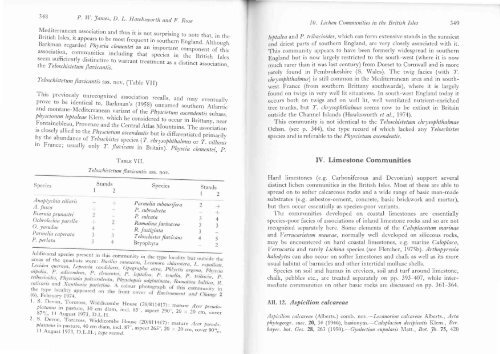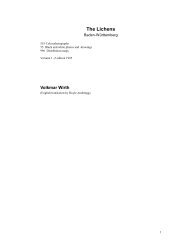Lichen communities in the British Isles: A preliminary conspectus
Lichen communities in the British Isles: A preliminary conspectus
Lichen communities in the British Isles: A preliminary conspectus
You also want an ePaper? Increase the reach of your titles
YUMPU automatically turns print PDFs into web optimized ePapers that Google loves.
348 P. W. James, f). L. Jlawkszoorth and F. Rose<br />
Mediterranean association anc{ thus it is not surpris<strong>in</strong>g<br />
<strong>British</strong><br />
to note<br />
<strong>Isles</strong>, it<br />
that,<br />
appears <strong>in</strong><br />
to<br />
thc<br />
be most fr.q,,.rrt i., ,o.rtt<br />
Barkman<br />
n.gf^"a.^,Cf<br />
regarded physcia though<br />
clementei;; ;; ".rl<br />
association, ".o--'niii.. i".r"ai.f il' .il:i"'J"il .,"#r,;ffil^"t<br />
seem sufficiently dist<strong>in</strong>ctive to 'r,arr<strong>in</strong>t treatment as a dist<strong>in</strong>ct association,<br />
<strong>the</strong> T elo s c his t etum fl aztic antrc.<br />
Teloschistetum flavicantis ass. nov. (Table VII)<br />
This previously unrecognized association recalrs,<br />
prove<br />
and<br />
to<br />
may<br />
be<br />
e'entually<br />
identical to, ,<br />
Barkman's (1958) unnamed sou<strong>the</strong>rn<br />
and montane-Mediterranean Atlantic<br />
variant oi <strong>the</strong> physcietunt<br />
ascendezlzs<br />
physciosum subass.<br />
leptaleae Klem. which h. .on.iJ"r.i to o..,r,<br />
Fonta<strong>in</strong>ebleau, provencc i., n.ir,urry, ,.,.r.<br />
and <strong>the</strong> centrar Atlas Mounta<strong>in</strong>s.<br />
is<br />
The<br />
closely<br />
association<br />
allied to <strong>the</strong> physuetu* nrrurdrn* o,r, is differentli.il.i*u.ity<br />
by <strong>the</strong> abundance of reLschist r .p..i..<br />
<strong>in</strong> 1i. ;;,:r:;";;;;;;;;;;::i'. zsiilosu.r<br />
France; usually only ?. yor.irars iri-nr;t^1,-r;. physcia clementei, p.<br />
Species<br />
Anaptychia ciliaris<br />
A. fusca<br />
Eoernia l>runastri<br />
Ochrolechia parella<br />
O. yasudae<br />
Parmelia caperata<br />
P. perlata<br />
Tesrn VII.<br />
T elo s c hrLs t e tum fl.aoic antis ass. nov.<br />
Stands<br />
72<br />
Additional species present <strong>in</strong> this community <strong>in</strong><br />
areas of <strong>the</strong> quadrats were : Bucllia , ,rrr",rr."'L<br />
Leridea '":<br />
eucrn(:n. Lphvnv<strong>in</strong> .n-)-t.,,.:- ,^ ,'<br />
t l;"i,);::?"<br />
.I<br />
2<br />
+ +<br />
J<br />
J<br />
l<br />
2<br />
;-t<br />
4<br />
Species Stands<br />
Parmelia subaurifera<br />
P. subrudecta<br />
P. sulcata<br />
Ramal<strong>in</strong>a far<strong>in</strong>acea<br />
R. fastigiata<br />
Teloschistes flaaicans<br />
Bryophyta<br />
t2<br />
2a<br />
-t<br />
3+<br />
-f<br />
33<br />
.'t -<br />
+5<br />
icombe.House (201811417): mature Acer pseutto-<br />
87o/o, 11 A .diam' r'ncl' B5', aspect 2g0", 20 x 20-.-, "or,.,<br />
2. S. Devon, s,_Widd.icombe House (201g11417): mature Ace.r pseudoplat.nus<br />
<strong>in</strong> pasture, 40 cm diam, i".1. gt-,;rp; ct265.,,20 x 20cm, cover 90(1,,,<br />
I I August 1973, D.L.H. ; typc rtrord."<br />
-L<br />
lij:<br />
10. <strong>Lichen</strong> Communities <strong>in</strong> <strong>the</strong> <strong>British</strong> <strong>Isles</strong> 3+9<br />
leptalea and P. tribacioides, which can form extensive stands <strong>in</strong> <strong>the</strong> sunniest<br />
and driest parts of sou<strong>the</strong>rn England, are very closely associated with it.<br />
This community appears to have been formerly widespread <strong>in</strong> southcrn<br />
England but is nor'v largely restricted to thc south-west (where it is now<br />
much rarer than it u'as last century) from Dorset to Cornwall and is more<br />
rarely found <strong>in</strong> Pembrokeshire (S. Wales). The twig facies (with ?.<br />
chrysophthalmas) is still common <strong>in</strong> <strong>the</strong> Mediterranean area and <strong>in</strong> southwest<br />
France (frorn sou<strong>the</strong>rn Brittany southwards), where it is largely<br />
found on twigs <strong>in</strong> very well lit situations. In south-west England today it<br />
occurs both on twigs and on u-ell lit, well ventilated nutrient-enriched<br />
tree trunks, but ?. chrysophthalmus seems now to be ext<strong>in</strong>ct <strong>in</strong> Brita<strong>in</strong><br />
outside <strong>the</strong> Channel Islands (Hawksworth et al., 1974).<br />
This community is not identical to <strong>the</strong> Teloschistetum chrysophthalmae<br />
Ochsn. (see p. 344), <strong>the</strong> type record of which lacked any Teloschistes<br />
species and is referable to <strong>the</strong> Physcietum ascendentis.<br />
IV. Limestone Cornmunities<br />
Hard limestones (e.g. Carboniferous and Devonian) support several<br />
dist<strong>in</strong>ct lichen <strong>communities</strong> <strong>in</strong> <strong>the</strong> <strong>British</strong> Islcs. Most of <strong>the</strong>se are able to<br />
spread on to softer calcareous rocks ancl a wide range of basic man-made<br />
substrates (e.g. asbestos-cement, concrete, basic brickwork and mortar),<br />
but <strong>the</strong>n occur esscntially as species-poor variants.<br />
The <strong>communities</strong> developed on coastal limestones are essentially<br />
species-poor facies of associations of <strong>in</strong>land limestone rocks and so are not<br />
recognized separately here. Some elements of <strong>the</strong> Caloplacetum mar<strong>in</strong>ae<br />
and Verrucarietum maurae, normally well developcd on siliceous rocks,<br />
may be encountered on hard coastal limestones, e.g. mar<strong>in</strong>e Caloplaca,<br />
Verrucaria and rarely Lich<strong>in</strong>a species (see Fletcher, 197-5b). Arthol>yrenia<br />
halodytes can also occur on softer limestones and chalk as well as its more<br />
usual habitat of barnaclcs and o<strong>the</strong>r <strong>in</strong>tertidal mollusc shells.<br />
Species on soil and humus <strong>in</strong> crevices, soil and turf around limestone,<br />
chalk, pebbles etc., are treated separately on pp. 393 +07, while <strong>in</strong>termediate<br />
<strong>communities</strong> on o<strong>the</strong>r basic rocks are discussed on pp. 361-36+.<br />
All. 12. Aspicilion calcareae<br />
Aspicilion calcareae (Alberts.) comb. nov.-l,ecanoriort calcareae Alberts., Acta<br />
phytogeogr. suec. 20, 3+ (1946), trasionym.-Caloplacion decipientis Klem., Ber.<br />
bayer. bot. Ges. 28, 263 (1950).-Gyalection cupularis Matt., Bol. |b. 75, +20





